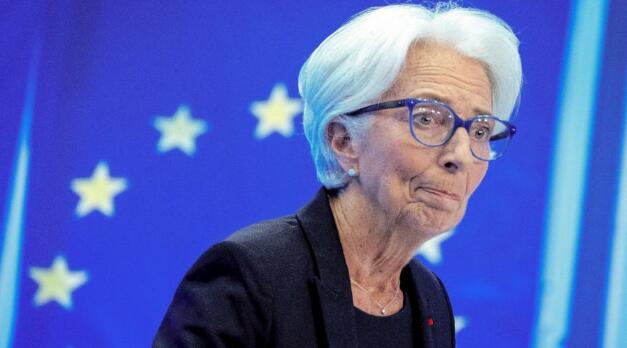Europe sees fastest pace of rate hikes since euro launched
FRANKFURT, Germany — The European Central Bank piled on another outsized interest rate hike aimed at squelching out-of-control inflation, increasing rates at the fastest pace in the euro currency’s history and underscoring the bank’s determination to control prices despite the threat of recession.
The 25-member governing council raised its interest rate benchmarks by three-quarters of a percentage point at a meeting Thursday in Frankfurt, matching its record increase from last month and joining the U.S. Federal Reserve in making a series of rapid hikes to tackle soaring consumer prices.
ECB President Christine Lagarde acknowledged the risk is growing that the 19-country eurozone may plunge into recession but says “inflation remains far too high” and will stay high for an extended period, so the bank expects to keep hiking.
“We are not done yet. There is more ground to cover,” she told reporters, despite bank expectations that the economy will weaken the rest of this year and beginning of next.
“In the present state of uncertainty, with the likelihood of recession looming much more on the horizon … everyone has to do their job,” Lagarde said. “Our job is price stability. This is our primary mandate, and we are riveted to that.”
Central banks around the world are rapidly raising interest rates that steer the cost of credit for businesses and consumers. Their goal is to halt galloping inflation fueled by high energy prices tied to Russia’s war in Ukraine, post-pandemic supply bottlenecks, and reviving demand for goods and services after COVID-19 restrictions eased. The Fed raised rates by three-quarters of a point for the third straight time last month.
Quarter-point increases have usually been the norm for central banks. But that was before inflation spiked to 9.9% in the eurozone, fueled by higher prices for natural gas and electricity after Russia slashed gas supplies during the war in Ukraine.
“A long-lasting war in Ukraine remains a significant risk,” Lagarde said. “Confidence could deteriorate further and supply side constraints could worsen again. Energy and food costs could also remain persistently higher than expected. A weakening world economy could be an additional drag on growth in the euro area.”
Inflation robs consumers of purchasing power, leading many economists to pencil in a recession for the end of this year and the beginning of next year in the 19 countries that use the euro as their currency. While inflation in the U.S. is near 40-year highs of 8.2%, fueled in part by more pandemic support spending than in Europe, the American economy grew in the third quarter after shrinking in the first half of 2022.
The ECB has now raised rates by a full 2 percentage points in just three months, distance that took 18 months to cover during its last extended hiking phase in 2005-2007 and 17 months in 1999-2000. The benchmark for short-term lending to banks now stands at 2%, a level last seen in March 2009.
The next meeting in December may see a smaller rate increase, analysts say.
“We expect the pace of hiking to slow, given that the window of opportunity to raise interest rates is narrowing with a recession in the euro area looming,” said Nicolas Sopel, senior macro strategist at Quintet Private Bank.
Higher rates can control inflation by making it more expensive to borrow, spend and invest, lowering demand for goods. But the effort to raise rates also has raised concerns about their impact on economic growth and on markets for stocks and bonds.
To sop up economic stimulus efforts that have outlived their purpose now that rates are rising, Lagarde encouraged banks to repay the cheap, long-term loans they received from the ECB to help them keep lending to businesses. The central bank raised the interest rates on the loans and said it would let banks voluntarily repay the money.
Another potentially fraught issue in drawing down stimulus without triggering turmoil in nervous markets is what to do with the bank’s 4.9 trillion euro ($4.9 trillion) pile of bonds bought under earlier efforts to lower market borrowing costs. That will be not be outlined until the December meeting, Lagarde said.
For now, the bank is maintaining the size of its holdings by using money from maturing bonds to buy new ones. Because the ECB is such a large bondholder, shrinking the bond pile could roil bond markets and make government borrowing costs more expensive.
The risks of bond market trouble were illustrated last month when then-U.K. Prime Minister Liz Truss announced tax cuts and spending increases that raised questions about state finances, triggering a sudden selloff in British government bonds and forcing her resign after 45 days in office.
Bond market turbulence also threatened to break up the eurozone during its 2010-2015 debt crisis. Now, borrowing costs for indebted eurozone governments such as Italy have risen along with ECB interest rates.
The euro flirted below parity with the dollar after the ECB decision and remains near its lowest levels in 20 years. A weaker euro worsens inflation by raising the price of imported goods.
Reasons for the drop in the exchange rate include higher U.S. interest rates that attract money into investments priced in dollars and, more broadly, the dwindling prospects for Europe’s economy.
